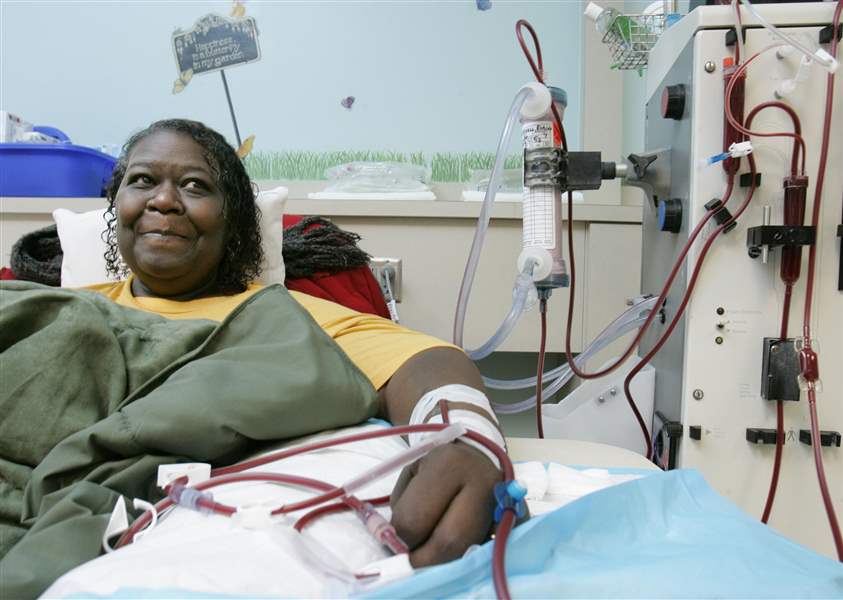
Proposed Ohio Constitution amendment would restrict kidney dialysis centers
7/15/2018
A patient receives dialysis treatment. Supporters are gathering signatures to place the Kidney Dialysis Patient Protection Amendment on the ballot in Ohio in November. The measure would be designed to increase regulation on outpatient dialysis centers
The Blade
Buy This Image
COLUMBUS — A proposed constitutional amendment that would restrict profits and increase regulations at Ohio outpatient dialysis centers is one step closer to getting on November’s ballot, pending certification of enough valid signatures to qualify.
The Kidney Dialysis Patient Protection Amendment is backed by Ohioans for Kidney Dialysis Patient Protection, an offshoot of a similar initiative California voters will consider in November. Supporters say it provides necessary regulations to a highly profitable industry, while opponents warn it would threaten patient care and close treatment centers.

The Kidney Dialysis Patient Protection Amendment is similar to a measure that will be in front of California voters in November.
“We’re already very regulated. It’s redundant,” said Diane Wish, president of the Ohio Renal Association, the trade group representing the 326 outpatient dialysis clinics in the state. “If the goal is to make dialysis more affordable for patients it’s not doing it. It’s not going back to the patient.”
The proposal would cap revenue from treatment at 115 percent of “direct patient care services costs and all health care quality improvement costs.” Dialysis centers that charge beyond that would be required to provide rebates to insurers and would face fines for noncompliance.
It would also require the state to inspect kidney dialysis centers annually, reviewing compliance for processes such as handling and disposal of biohazardous waste, cleaning and maintenance of equipment, and adherence to patient-care plans.
The 349 Ohio Department of Health-licensed dialysis centers in the state are on a three-year schedule in line with federal guidelines, said J.C. Benton, state health department spokesman.
The pro-amendment group, backed by the Service Employees International Union, says it has turned in enough petition signatures to put the issue on the statewide ballot, which will be verified by the Ohio Secretary of State’s Office by July 24. At least 305,591 valid signatures are required.
Anthony Caldwell, spokesman for SEIU District 1199 and a member of the petitioner committee, said the amendment will address huge mark-ups dialysis centers charge patients with private insurance and strengthen safety and hygiene regulations.
“We feel like to have that kind of very acute care that you should have that done in the safest, cleanest environment possible,” Mr. Caldwell said, adding the amendment would ensure “the money they are charging is going to care for consumers [so it is] done in safe and sanitary conditions.”
Dialysis is a costly and time-consuming medical procedure used to treat patients with kidney failure, or end-stage renal disease. Patients typically visit such clinics three days a week for about four hours at a time to have their blood extracted, filtered, and returned to their body through a machine. In 2016, about 18,000 Ohioans were on dialysis, according to the Ohio Renal Association.
Both the Ohio and California issues are funded in large part by SEIU-United Healthcare Workers. A coalition of groups against the amendment, under the umbrella Ohioans Against the Reckless Dialysis Amendment, includes the Kidney Foundation of Ohio, Ohio Renal Association, and the Ohio State Medical Association.
Ms. Wish, also a registered nurse and chief executive officer of Centers for Dialysis Care, a chain of nonprofit dialysis providers in northeast Ohio, said proponents of the measure would like people to believe the dialysis industry has no regulation.
It’s something that “could not be any further from the truth,” she said, citing adherence to federal guidelines and state inspections.
By capping revenue, Ms. Wish said it doesn’t make it more affordable for dialysis patients, as rebates go back to the insurance companies.
About 90 percent of dialysis patients have Medicaid or Medicare, she said, both exempt in the proposed amendment. In targeting private insurance, it reduces necessary revenue to offset lower reimbursements from government payers, she said.
She warned the amendment could cause some centers to close or consolidate, especially in rural areas where patient volumes are lower.
“Patients will have to travel farther and transportation is very difficult,” she said, adding that increased travel makes missing treatments and adverse side effects requiring hospitalizations more likely. “It’s just not good for patients.”
Mr. Caldwell said a revenue cap would incentivize dialysis centers to invest money back into direct patient care, which could include increased staffing or other safeguards to improve conditions, rather than giving it to shareholders.
Dialysis centers charge private insurance “a 350-percent markup” from the actual cost of care, far more than government insurers who negotiate rates. That cost is passed on to all private insurance customers, he said.
Mr. Caldwell’s union, which also represents Ohio Department of Health surveyors responsible for inspecting dialysis clinics, said reports of unclean or unsafe conditions warrant this action.
The 2017 U.S. Renal Data System Annual Data Report shows nearly 500,000 Americans received dialysis treatments in 2015. That year, total Medicare spending for beneficiaries with kidney disease was nearly $100 billion, according to the report.
Contact Lauren Lindstrom at llindstrom@theblade.com, 419-724-6154, or on Twitter @lelindstrom.